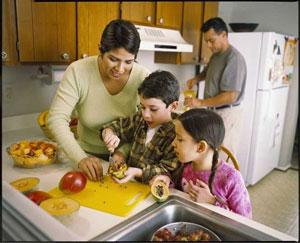Planning meals ahead of time can improve health while saving time and money. Getting children involved in planning and cooking meals can have benefits for the whole family, too. August is Kids Eat Right Month™, a nutrition education, information-sharing and action campaign created by the Kids Eat Right program, an initiative of the Academy of Nutrition and Dietetics and its Foundation. Kids Eat Right Month™ spotlights healthy nutrition and active lifestyles for children and families, offering tips to help families cook healthy, eat right, and be active.
 Tips to cook healthy, eat right, and be active:
Tips to cook healthy, eat right, and be active:
Kid friendly kitchen tasks. Children ages 3 to 5 can use cookie cutters, rinse produce, clear tabletops, mix simple ingredients, and use pieces of fruit to craft fun shapes. Six- to 7-year-olds can crack eggs in a bowl, de-seed peppers and tomatoes, stir and prepare instant pudding, and prepare lettuce for a salad. Eight- to 9-year-olds can rinse and clean vegetables, use a can opener, beat eggs, measure and mix dry ingredients, and use a food thermometer. Ten- to 12-year-olds can boil pasta and vegetables, simmer ingredients on the stovetop, follow a simple step-by-step recipe, slice and chop vegetables, and bake and microwave foods.
Don't forget food safety basics. Clean all countertops and kitchen surfaces prior to cooking. Remember to pull back long hair. Never taste food until it is done cooking. When children are assisting with meal preparation, make sure there is always adult supervision. Always use clean utensils. Wash hands in warm, soapy water before and after handling food.Eat right and be active for healthy children. Factors that can affect childhood nutrition include number of meals eaten away from home, portion sizes, types of beverages consumed (especially those high in added sugars), and meal patterns and frequency. It's important to pay attention not only to nutrition, but also physical activity levels. Encourage kids to participate in physical activities that are fun, age-appropriate, and provide variety. Current recommendations state kids should get 60-plus minutes of activity daily.
Learn more about how to cook healthy, eat right, and be active at www.eatright.org/resources/for-kids. For more food, nutrition and health information from Nebraska Extension go to www.food.unl.edu.
Feel free to use/adapt Healthy Bites material (with credit) for your own articles, blogs, handouts, etc. An example credit line would be: Authored by or Adapted from Lisa Franzen-Castle, PhD, RD, University of Nebraska-Lincoln Extension Nutrition Specialist. Healthy Bites Newsletter, August 2015, at http://go.unl.edu/33md.
Download a printable copy of this month's Health Bites Newsletter (PDF, 569kb)
More resources:
All the Healthy Bites. Healthy Bites is a newsletter that focuses on a different food, nutrition and / or health theme for each month.
Cook it Quick. Our goal is to make you "hungry for healthy food" by offering tips and delicious, quick-to-prepare, inexpensive recipes.
Food Reflections. Food Reflections is a monthly email newsletter. Each issue provides a "how-to" message on food, nutrition, or food safety for health professionals, educators, and consumers.Family Fun on the Run. Monthly newsletters are designed to help you achieve a healthier lifestyle by making walking an important part of your personal fitness program.
Food Fun for Young Children. Serving up quick, healthy snack ideas for younger children.Nebraska Extension Food, Nutrition, and Health by the Month Calendar. National Food Days, Weeks, and Months for August.
Basic Foods for Cupboard, Fridge and Freezer: Create Your Own List! Are you tired of all the planning, hunting and gathering needed to find the ingredients required for many recipes? Would you like to go to your cupboard, refrigerator or freezer and already have most -- if not all -- the ingredients needed to make a meal? This list of foods can be combined and recombined in a variety of new, delicious ways. They are offered as a starter list to help you begin developing a list that works for you.